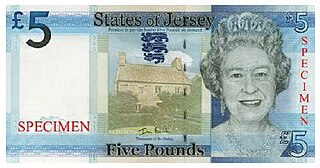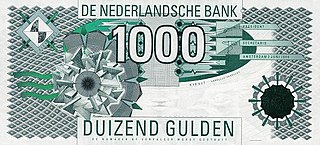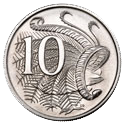
The standard circulating coinage of the United Kingdom, British Crown Dependencies and British Overseas Territories is denominated in pennies and pounds sterling, and ranges in value from one penny sterling to two pounds. Since decimalisation, on 15 February 1971, the pound has been divided into 100 pence. Before decimalisation, twelve pence made a shilling, and twenty shillings made a pound.

The CFP franc is the currency used in the French overseas collectivities of French Polynesia, New Caledonia, and Wallis and Futuna. The initials CFP originally stood for colonies françaises du Pacifique but since 2022 is officially Collectivités françaises du Pacifique. Its ISO 4217 currency code is XPF. The CFP franc is subdivided into 100 centimes, although there are no centime denominations. The currency is issued by Institut d'émission d'outre-mer (IEOM).

The lira was the currency of Italy between 1861 and 2002. It was introduced by the Napoleonic Kingdom of Italy in 1807 at par with the French franc, and was subsequently adopted by the different states that would eventually form the Kingdom of Italy in 1861. It was subdivided into 100 centesimi, which means "hundredths" or "cents". The lira was also the currency of the Albanian Kingdom from 1941 to 1943.

The pound was the currency of Australia from 1910 until 14 February 1966, when it was replaced by the Australian dollar. Like other £sd currencies, it was subdivided into 20 shillings, each of 12 pence.
The pound is the currency of Guernsey. Since 1921, Guernsey has been in currency union with the United Kingdom and the Guernsey pound is not a separate currency but is a local issue of sterling banknotes and coins, in a similar way to the banknotes issued in Scotland, England and Northern Ireland. It can be exchanged at par with other sterling coinage and notes.
The vatu is the currency of Vanuatu. It has no subdivisions.

The Somaliland shilling is the official currency of the Republic of Somaliland, an unrecognised sovereign state in the Horn of Africa, recognised internationally as de jure part of Somalia.

The Kina is the currency of Papua New Guinea. It is divided into 100 toea. The name Kina is derived from Kuanua language of the Tolai region, referring to a callable pearl shell used widely for trading in both the Coastal and Highlands areas of the country.
The Jamaican dollar has been the currency of Jamaica since 1969. It is often abbreviated to J$, the J serving to distinguish it from other dollar-denominated currencies. It is divided into 100 cents, although cent denominations are no longer in use as of 2018. Goods and services may still be priced in cents, but cash transactions are now rounded to the nearest dollar.

The pound is the currency of Jersey. Jersey is in currency union with the United Kingdom, and the Jersey pound is not a separate currency but is an issue of banknotes and coins by the States of Jersey denominated in sterling, in a similar way to the banknotes issued in Scotland and Northern Ireland. It can be exchanged at par with other sterling coinage and notes.
The pound, or Manx pound, is the currency of the Isle of Man, at parity with sterling. The Manx pound is divided into 100 pence. Notes and coins, denominated in pounds and pence, are issued by the Isle of Man Government.
The Saint Helenapound is the currency of the Atlantic islands of Saint Helena and Ascension, which are constituent parts of the British Overseas Territory of Saint Helena, Ascension and Tristan da Cunha. It is fixed at parity with sterling, and so both currencies are commonly accepted and circulated within Saint Helena. It is subdivided into 100 pence.
There have been three sets of coins in Ireland since independence. In all three, the coin showed a Celtic harp on the obverse. The pre-decimal coins of the Irish punt had realistic animals on the reverse; the decimal coins retained some of these but featured ornamental birds on the lower denominations; and the euro coins used the common design of the euro currencies. The pre-decimal and original decimal coins were of the same dimensions as the same denomination British coins, as the Irish punt was in currency union with the British pound sterling. British coins were widely accepted in Ireland, and conversely to a lesser extent. In 1979 Ireland joined the Exchange Rate Mechanism and the Irish punt left parity with sterling; coin designs introduced after this differed between the two countries.
The tālā is the currency of Samoa. It is divided into 100 sene. The terms tālā and sene are cognates of the English words dollar and cent in the Samoan language. Its symbol is $, or WS$ to distinguish it from other currencies named dollar.

The guilder or florin was the currency of the Netherlands from 1434 until 2002, when it was replaced by the euro.

The Kiribati dollar is one of the two official currencies of Kiribati. The Kiribati coins are pegged at 1:1 ratio to the Australian dollar, the other official currency of Kiribati. Kiribati coins were issued in 1979 and circulate alongside banknotes and coins of the Australian dollar. In present day, Kiribati coins are rare in comparison to Australian coins with the last minor emission made in 1992, and these old coins are now generally collectors items. The complete emissions of coins were made in 1979 and in 1989 for the tenth anniversary of independence.

The Australian ten-cent coin is a coin of the decimal Australian dollar. When the dollar was introduced as half of an Australian pound on 14 February 1966, the coin inherited the specifications of the pre-decimal shilling; both coins were worth one twentieth of a pound and were called "bob". On introduction it was the fourth-lowest denomination coin. Since the withdrawal from circulation of the one and two cent coins in 1992, it has been the second-lowest denomination coin in circulation.

Christopher Ironside OBE, FRBS was a British painter and coin designer, particularly known for the reverse sides of the new British coins issued on decimalisation in 1971.
The coins of the New Zealand dollar are used for the smallest physical currency available in New Zealand. The current denominations are ten cents, twenty cents, fifty cents, one dollar and two dollars. The $1 and $2 coins are minted in a gold colour, the 20c and 50c coins are silver colour and the 10c coin is plated in copper.

The Australian sixpence circulated from 1910 up until the decimalisation of Australian Currency in 1966. The coins were initially minted in England; however, Australia began to mint their own from the year of 1916 at branches of the Royal Mint in Sydney and Melbourne. The coins which made up Australia's pre-decimal currency were identical to British currency in the characteristics of weight and size. The Coinage Act of 1909–1947, authorised the issue of Australian coins in the select denominations, including the sixpence. By 1916 all silver denominations, including the sixpence, could be minted at the Royal Mint branch in Melbourne. Unique Australian currency was created with decimalisation in 1966.















